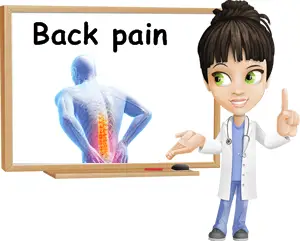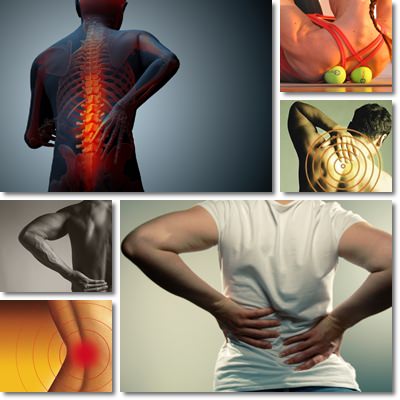While it may not sound like a very serious medical condition, back pain often engenders almost debilitating pain in the back area that renders one unable to carry on with work or normal life as it is.
The source of pain can be located in the cervical, thoracic, lumbar or sacral spine area and can originate from muscles, nerves, joints, vertebrae or the spine itself. Both innate and acquired forms of back pain exist and all give a whole new meaning to the phrase excruciating pain. Whether it’s acute or chronic, back pain is debilitating.
The onset of back pain can be either acute or chronic and the pain itself may be either intermittent or constant.
Depending on the area of the back where the pain is left as well as on its severity, a medical professional can give an accurate diagnosis relying on medical history and selected tests. Because the pain may be either fixed or radiate to other areas and triggered by an insidious, potentially dangerous health issue, reaching for a medical professional is pivotal to better understanding and managing the condition.

Back pain can be harmless or it can mess up one’s life to a great extent if left untreated. Bad posture, strain from physical effort either at the job or at home, carrying heavy things, weight gain and associated spinal cord curving, a sedentary lifestyle, existent spinal cord problems, muscle ruptures as well as several other factors may engender severe back pain.
Even more, the pain may worsen as a result of humidity, carrying weights, making sudden moves, lifting things or undergoing physical effort without stretching and warming up first etc.
In some people, the pain may radiate to the shoulder blades, arms, neck or head as well as other areas of the back. The most telling symptom accompanying the condition is, as expected, a dull, sharp or burning pain located in various areas of the back.
Studies estimate that about 9 out of 10 adults have experienced back pain at least once in their lifetime, while 5 out of 10 people with physically demanding jobs suffer from recurrent back pain.
Signs and symptoms Of Back Pain
Aside from the different levels of pain in various parts of the back, back pain may be accompanied by one or more of the following symptoms:
1) Tingling. In cases of severe back pain, tingling or pins and needles sensations may be experienced either in the hands or legs. They are often mistaken for either poor blood circulation problems or hypoglycemia (low levels of sugar in the blood).
2) Numbness. A feeling of numbness in a limb or the sensation it has fallen asleep or that you don’t feel like it belongs to your body may suggest that a severe back pain is radiating to arms and legs causing them to feel like this.
3) Fasciculations. Involuntary muscle twitching, spasms or cramps, also known as fasciculations, may be symptoms of back pain.
When you notice the skin on your thigh muscle twitching or a finger moving involuntarily and you also have back pain, then the two might be correlated.
However, any form of involuntary muscle spasms may be the result of a magnesium deficiency which, if severe, may engender other magnesium deficit-related problems.

Types of back pain
It is important to know that back pain may not feel the same for everyone or originate in the same places. Nonetheless, all of the above types fall into the general category of back pain:
1) Cervical spine pain
This type of back pain affects the neck area with its 7 vertebrae, along with their discs and ligaments. The elderly are a high risk category for cervical pain, but it can also be a result of jobs that require heavy lifting or bad posture such as construction working, jobs that require sitting at a desk all day long, squinting at something (you also tend to lean the head forward in such cases), overall lack of physical activity and bad posture.
Smoking, aging and injuries are also risk factors. Common symptoms include headaches in the back of the head especially, stiffness of the neck, tingling or numbness sensations, dizziness, imbalance, reduced mobility in the neck.
2) Upper back pain or thoracic spine pain
This type of back pain occurs at the level of the thorax made up of 12 thoracic vertebrae that connect with the rib cage. Pain originating in this area can radiate to shoulder blades, shoulders and arms and cause discomfort when moving.
Because this part of the back is designed to remain fixed in order to offer support and stability for the whole body, it is rarely caused by spinal cord or disc problems. Bad posture, injuries or strain, joint problems or muscle strains and ruptures are the leading causes for upper back pain.
3) Lower back pain or lumbar spine pain
There are 5 vertebrae in the lumber spine area which confer mobility to the abdominal region. Joint problems, muscle strain, disc degeneration, osteoarthritis, problems with the sciatic nerve are all potential causes for lower back pain.
4) Sacral spine pain
Pain in this area originates from the sacrum, a large bone made from 5 vertebrae fused together. Joint problems, fractures as a result of trauma or injury, osteoporosis or arthritis are all possible causes.
How long does Back Pain last?
How long does back pain take to go away?
Typically, back pain may last anywhere from a few days to several weeks and up to 3 or 6 months. Recovery time is highly dependent on the severity and cause of the pain. Being carefully not to strain the back during this time also contributes immensely to a faster recovery.
Here are a few estimates regarding the time needed for your back pain to go away:
- Acute pain may last up to 12 weeks. It is the severe state and is usually characterized by a rapid onset, sometimes short duration. It is diagnosed rapidly.
- Subacute pain is the second stage (a sort of subtype) of acute pain and may last anywhere from 6 to 12 weeks.
- Chronic pain. If the subacute pain persists for more than 12 weeks, it is considered chronic pain.
Back pain is almost always the result of injury or trauma from carrying heavy weights or bad posture. It is related either to the soft tissues (muscles, ligaments) or nerves (spinal nerve, nerve roots). In extremely rare cases, infections or cancer may cause back pain.
Several studies also suggest that back pain can be a side effect of chronic stress. More important, it should resolve itself with time (days, weeks, months) and may only require medical supervision, anti-inflammatory prescriptions, rest, mild exercise such as stretching or physical therapy.
What is the best approach when dealing with back pain?
How can we manage it so it doesn’t interfere with our life and how do we treat it?
Here is a list of 7 therapies and treatments for back pain:
1) Heat therapy is based on the use of infrared lamps that heat up the muscles, helping relax them and thus relieving pain and tension (see the benefits of infrared lamp). Hot baths or showers are also preferred by some sufferers, while others opt for warm compresses, moist heating pads, heat patches, etc.
2) Cold therapy involves the use of cold compresses, cold packs or ice packs. Cold helps relieve pain and stiffness, numbs the affected area and reduces inflammation. Local spray recommended by your doctor may also work.
3) Massage. It can be practiced at home with almost similar results to the professional one. The aim is to improve blood circulation to the affected area and relieve muscle tension and stiffness causing the pain. An oil made from anti-inflammatory herbs may help greatly.
If performed regularly (once or twice a day for at least 20-30 minutes), it can significantly reduce healing time and manage pain severity, provided you restrain from physical effort in the meantime to let the back recover.
4) Movement therapy. People suffering from back pain would benefit immensely from movement therapy in the form of stretching, mild physical exercise such as Pilates, all under the careful supervision of a professional.
Stretching the body gently and simply making it move, without any strain whatsoever, can help improve blood circulation, relieve tension, improve muscle tone, flexibility, balance and relax them, relieve pain and stress.
5) Vitamins and minerals. Meeting your daily vitamin and mineral requirements is pivotal to keeping in good health, including back health. Vitamin C, in particular, is a powerful anti-inflammatory which stimulates the production of collagen, the main structural protein making up connective tissue from the spinal cord.
Magnesium is a dietary mineral supporting muscle function and required for muscle health. Other nutrients that may support muscle health are potassium, calcium, vitamins A and D.
6) Medication for the treatment of back pain should be prescribed by a medical professional after identifying the cause of the pain. Muscle relaxants and anti-inflammatory medication are commonly prescribed in such cases. Surgery is only resorted to if all other treatment options have failed, but is a rare occurrence.
7) Rest. Avoiding heavy lifting, straining exercise, physical work and resting a lot will contribute to a faster recovery and less severe pain. So give yourself a break and lie down in bed a little. Pregnant women suffering from back pain are absolutely require rest and are advised to avoid heavy lifting and strenuous physical exercises for the entire duration of their pregnancy. More detailed advice, suited to personal needs, should come from your doctor.
